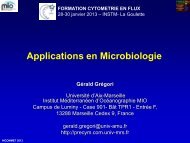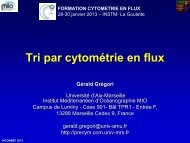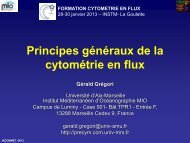Eukaryotic Picoplankton in Surface Oceans - incommet
Eukaryotic Picoplankton in Surface Oceans - incommet
Eukaryotic Picoplankton in Surface Oceans - incommet
Create successful ePaper yourself
Turn your PDF publications into a flip-book with our unique Google optimized e-Paper software.
Annu. Rev. Microbiol. 2011.65:91-110. Downloaded from www.annualreviews.org<br />
by CSIC - Consejo Superior de Investigaciones Cientificas on 09/27/11. For personal use only.<br />
a<br />
MALV-2<br />
D<strong>in</strong>oflagellates<br />
MALV-1<br />
Ciliates<br />
MALV-3<br />
MALV-5<br />
Other alveolates<br />
Diatoms<br />
MAST-4 (6-11)<br />
MAST-3 (12)<br />
Chrysophytes<br />
MAST-1<br />
Dictyochophytes<br />
Bicosoecids<br />
Bolidophytes<br />
Pelagophytes<br />
Pirsonids<br />
Labyr<strong>in</strong>thulids<br />
Other stramenopiles<br />
Radiolaria/Polycyst<strong>in</strong>ea<br />
Radiolaria/Acantharea<br />
Radiolaria/RAD B<br />
Cercomonads<br />
Radiolaria/RAD A<br />
Chlorarachniophytes<br />
Other Rhizaria<br />
Pras<strong>in</strong>ophytes<br />
Trebouxiophytes<br />
Other Archaeplastida<br />
Haptophytes<br />
Cryptophytes<br />
Telonemia<br />
Picobiliphytes<br />
Other CCTH<br />
Diplonemids<br />
K<strong>in</strong>etoplastids<br />
Other Excavata<br />
Choanoflagellates<br />
Other Opisthokonta<br />
Amoebozoa<br />
Not classified<br />
Figure 4<br />
Number of sequences <strong>in</strong> molecular surveys<br />
0 500 1,000 1,500 2,000<br />
Alveolata<br />
Stramenopiles<br />
Rhizaria<br />
Archaeplastida<br />
CCTH<br />
Excavata<br />
Opisthokonta<br />
Amoebozoa<br />
Not classified<br />
Percentage of sequences<br />
per group (set 2,175)<br />
OTUs per group<br />
b<br />
c<br />
20<br />
15<br />
10<br />
5<br />
0<br />
d<br />
1,500<br />
1,000<br />
500<br />
0<br />
M<br />
P<br />
C<br />
0 5 10 15 20<br />
Percentage of sequences<br />
per group (set 8,719)<br />
y = 0.82x<br />
R 2 = 1.00<br />
y = 0.46x<br />
R 2 = 0.98<br />
y = 0.17x<br />
R 2 = 0.91<br />
0 500 1,000 1,500 2,000<br />
Sequences per group<br />
(a) Taxonomic affiliation of 18S rDNA sequences retrieved <strong>in</strong> mar<strong>in</strong>e protist surveys (metazoa and fungi<br />
excluded). The 8,719 sequences derive from seawater clone libraries done with eukaryotic primers (∼90%<br />
from surface protists; ∼67% from surface picoeukaryotes). (b) Sequence contribution of eukaryotic<br />
supergroups. (c) Comparison of a group’s relative abundance with a dataset of 2,175 sequences from surface<br />
picoeukaryotes (55). Groups deviat<strong>in</strong>g from the 1:1 l<strong>in</strong>e are pras<strong>in</strong>ophytes (P), MAST (M), ciliates (C), and<br />
d<strong>in</strong>oflagellates (D). (d ) Number of operational taxonomic units (OTUs) contributed per group as a function<br />
of its number of sequences, at 100% OTU cluster<strong>in</strong>g level (blue dots), 99% ( green dots), and 95% ( yellow dots).<br />
Data from M. Pernice (unpublished data). Abbreviations: CCTH, cryptophytes, centrohelids, telonemids,<br />
plus haptophytes.<br />
D<br />
www.annualreviews.org • Mar<strong>in</strong>e Picoeukaryotes 99








